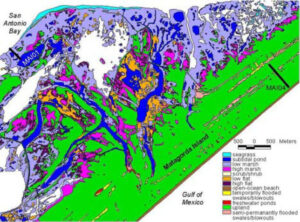Back to: ZOOLOGY 500 Level
Welcome to class!
Welcome, brilliant mind! It’s always great to have you here. Today’s topic is a very important one, especially for anyone serious about ecology, environmental conservation, or even sustainable development in Africa. We’re looking at habitat mapping and classification—a vital skill that helps scientists and conservationists understand, manage, and protect the natural environments that support life across Nigeria and the rest of the continent.
Habitat Mapping And Classification
What is Habitat Mapping?
Habitat mapping is the process of identifying and recording the types, locations, and characteristics of different habitats within a specific area. Think of it like creating a “geographical blueprint” of where animals and plants live.

Imagine you’re studying Gashaka Gumti National Park, Nigeria’s largest national park. Habitat mapping would help you know which parts are rainforest, savannah, or riparian zones, and where different species like chimpanzees or pangolins are likely to be found.
What is Habitat Classification?
Habitat classification involves grouping habitats into categories based on their characteristics, such as vegetation type, soil, climate, and the kinds of species they support.
For example:
Forest habitats: Like those in Cross River, with tall trees, rich biodiversity, and humid climate.
Savannah habitats: Like the open grasslands of Kainji, with scattered trees and seasonal rainfall.
Wetland habitats: Such as the Hadejia-Nguru wetlands, where the land is seasonally flooded and supports fish, birds, and aquatic plants.
Why Habitat Mapping and Classification Matter
Biodiversity protection: Knowing where habitats are helps us protect the species that live there.

Land-use planning: It guides where roads, farms, or buildings should be placed without destroying key ecosystems.
Conservation efforts: It helps NGOs and government agencies plan protected areas or wildlife corridors.
Climate change monitoring: Mapping helps track changes in habitats over time due to global warming or deforestation.
Tools and Techniques
Modern ecologists use several tools for mapping:
GPS (Global Positioning System): To record exact habitat locations.
GIS (Geographic Information System): To analyse and display habitat maps on a computer.
Satellite imagery and drones: To get a bird’s-eye view of large areas and detect patterns not visible on the ground.
Field observations: For detailed notes, photos, and sketches of vegetation and animal signs.
Example from Nigeria
In the Niger Delta region, scientists use GIS tools to map mangrove forests—vital habitats for fish, crabs, and birds. This mapping has helped fight oil pollution by identifying sensitive areas in need of urgent protection.
Steps in Habitat Mapping and Classification
Survey the Area: Visit and study the environment.
Collect Data: Take notes, pictures, and GPS points.
Classify Habitats: Group areas based on plant type, water presence, soil, and other features.
Create Maps: Use digital tools or hand-drawn sketches to visualise the habitat layout.

Update Regularly: Habitats change, so maps must be updated to stay useful.
Summary
- Habitat mapping shows where and what types of habitats exist in a location.
- Classification helps group habitats into meaningful categories.
- These processes support conservation, planning, and environmental monitoring.
- Tools like GPS, GIS, drones, and fieldwork are essential for accurate mapping.
Evaluation
- What is the difference between habitat mapping and classification?
- Name three types of habitats commonly found in Nigeria.
- How does habitat mapping help in conservation planning?
- List two modern tools used in habitat mapping.
You’re learning how to read the language of the land itself! Every skill you gain brings you closer to becoming a top-tier ecologist ready to solve real-world problems. Keep going—you’re doing amazing things, and Afrilearn is always proud to walk this journey with you!
